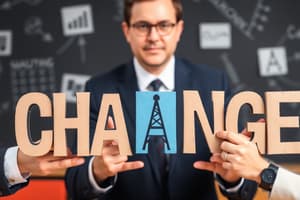Podcast
Questions and Answers
Which of the following forces behind change primarily focuses on statistical data related to a specific population within a defined area?
Which of the following forces behind change primarily focuses on statistical data related to a specific population within a defined area?
- Demographics (correct)
- Environmental
- Economic
- Technological
Resistance to change is solely based on logical reasoning and rational analysis of potential disadvantages.
Resistance to change is solely based on logical reasoning and rational analysis of potential disadvantages.
False (B)
Describe a strategy that could be implemented to proactively mitigate resistance to change.
Describe a strategy that could be implemented to proactively mitigate resistance to change.
One effective strategy is to foster a climate of trust within the organization. This enables open communication and ensures that there is consistent support for the changes in order to address any concerns the individuals may have.
___________ are subjective opinions that can be influenced by external factors, differing from objective truths.
___________ are subjective opinions that can be influenced by external factors, differing from objective truths.
Match each term with its correct association:
Match each term with its correct association:
Which component of organizational culture represents deeply ingrained values and beliefs that are often taken for granted within the organization?
Which component of organizational culture represents deeply ingrained values and beliefs that are often taken for granted within the organization?
Organizational culture primarily impacts external stakeholder relations but has minimal influence on internal employee behavior.
Organizational culture primarily impacts external stakeholder relations but has minimal influence on internal employee behavior.
Explain how organizational culture helps team members adjust spiritually.
Explain how organizational culture helps team members adjust spiritually.
_____, enacted in 1972, mandates equal access to education, including athletics, irrespective of gender.
_____, enacted in 1972, mandates equal access to education, including athletics, irrespective of gender.
Match the concept with its correct details:
Match the concept with its correct details:
What is the primary focus of a learning organization?
What is the primary focus of a learning organization?
Increased knowledge within a learning organization primarily leads to enhanced operational efficiency, with minimal impact on innovation.
Increased knowledge within a learning organization primarily leads to enhanced operational efficiency, with minimal impact on innovation.
Describe the critical role of HR in a learning organization.
Describe the critical role of HR in a learning organization.
____ analysis is an organization development intervention that helps analyze the driving and restraining forces affecting a change situation.
____ analysis is an organization development intervention that helps analyze the driving and restraining forces affecting a change situation.
Match each organization development (OD) intervention with its primary focus:
Match each organization development (OD) intervention with its primary focus:
What is the primary goal of the initial climate-building step in team building?
What is the primary goal of the initial climate-building step in team building?
The structure and team dynamics evaluation phase of team building focuses primarily on assessing individual performance metrics rather than team interaction patterns.
The structure and team dynamics evaluation phase of team building focuses primarily on assessing individual performance metrics rather than team interaction patterns.
Describe the method for identifying problems in the third step of team building.
Describe the method for identifying problems in the third step of team building.
During the problem-solving step of team building, the team proactively develops a solution in order of _________.
During the problem-solving step of team building, the team proactively develops a solution in order of _________.
Match each step of team building with its corresponding activity:
Match each step of team building with its corresponding activity:
Flashcards
Forces Behind Change
Forces Behind Change
Forces that drive change: Environmental, Economical, Social, Demographics and Technological. Variables of change help anticipate and predict change.
Why People Resist Change
Why People Resist Change
People resist change due to uncertainty, inconvenience, threatened self-interest, fear of loss, and lack of control.
Overcoming Resistance to Change
Overcoming Resistance to Change
Overcome resistance by building trust, planning changes, explaining the need, creating win-win situations, and involving people with support.
Facts
Facts
Signup and view all the flashcards
Beliefs
Beliefs
Signup and view all the flashcards
Values
Values
Signup and view all the flashcards
Organizational Culture
Organizational Culture
Signup and view all the flashcards
Title IX
Title IX
Signup and view all the flashcards
Learning Organization
Learning Organization
Signup and view all the flashcards
Organization Development Interventions
Organization Development Interventions
Signup and view all the flashcards
Team Building (6 steps)
Team Building (6 steps)
Signup and view all the flashcards
Study Notes
- Change is influenced by environmental factors (both internal and external), economic conditions, social norms and culture, demographics (target market, population), and technological advancements.
- Anticipating and predicting change is crucial for proactively shaping or adequately preparing for it. Variables of change enable you to plan and mitigate issues before they arise.
Why People Resist Change
- Uncertainty breeds fear, and inconvenience can be off-putting.
- Perceived threats to self-interest and fear of loss contribute to resistance.
- A lack of control exacerbates resistance to change.
Overcoming Resistance (PROMOTE LEARNERS)
- Foster a climate of trust.
- Develop a comprehensive change plan.
- Clearly communicate the need for change and its impact on individuals.
- Aim for win-win situations.
- Involve people in the process and provide ample support.
Fact, Belief, and Value Identification
- Facts are objective and can be proven.
- Beliefs are subjective opinions that cannot be proven and are influenced by external factors.
- Values are what individuals deem worth pursuing, guiding ethical behavior and decisions.
- Values often take precedence over facts in decision-making.
Importance of Culture
- Organizational culture encompasses shared values, beliefs, and standards that dictate acceptable behavior.
- Understanding organizational culture is pivotal for comprehending its functioning and fitting in.
- Assumptions are deeply ingrained values and beliefs that are accepted without question.
Culture Component Functions
- Instructing people, constructing standards, recovery, spiritual adjustment.
- Meeting psychological and social demands
Importance of Diversity
- Title IX of the Amendments to the Higher Education Act, passed in 1972, mandates equal access to education, including athletics, for women.
- Consequently, the number of women participating in college sports has surged from 32,000 to approximately 163,000.
Learning Organization
- A learning organization can adapt and change with its environment to continuously improve customer value.
- It leads to increased knowledge, fostering creativity and innovative action.
- Human resources is key- Hiring the right people and promoting diversity are essential elements.
Organization Development (OD) Interventions
- Training and development programs
- Force field analysis
- Survey feedback
- Grid OD
- Sensitivity training
- Process consultation
- Job design
- Direct feedback
Steps of Team Building
- Climate building and goal setting: establish trust, support, and openness.
- Structure and team dynamics evaluation: improve work processes and collaboration by evaluating strengths and weaknesses.
- Problem identification: use interviews and surveys to pinpoint problems.
- Problem solving: develop proactive solutions based on priority.
- Training: address the group's problems through targeted training.
- Closure: summarize accomplishments, commit to performance improvement, and assign follow-up tasks.
Studying That Suits You
Use AI to generate personalized quizzes and flashcards to suit your learning preferences.




